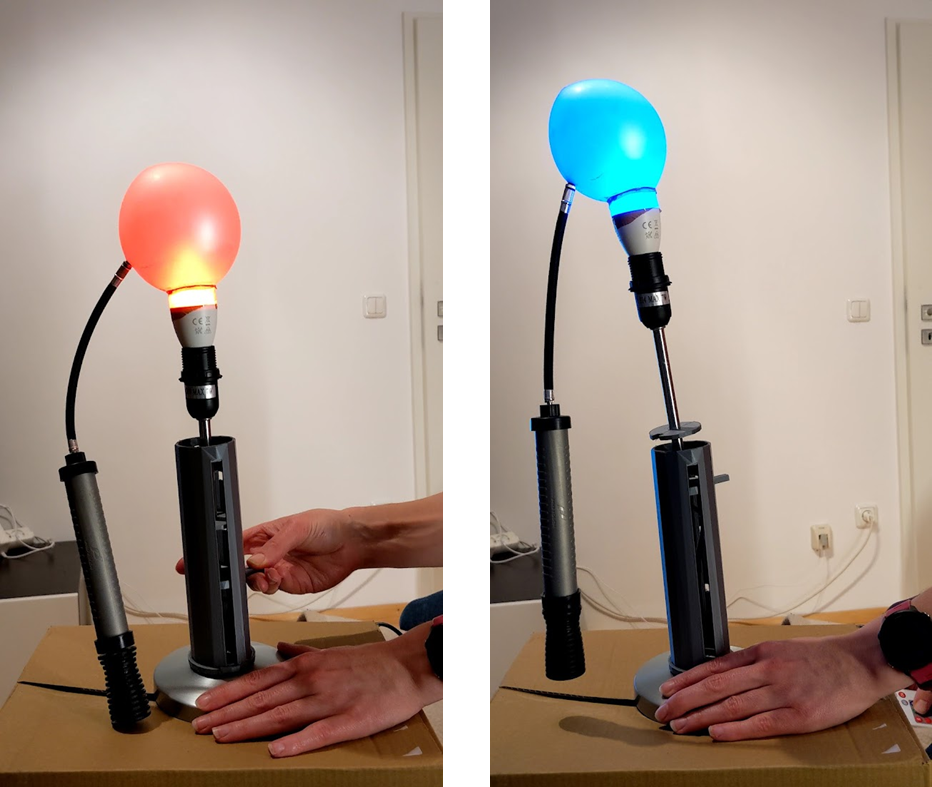After the haptification of the lies, which we presented in our last blog post, we started to go into the physicalization. The goal of the phyicalization is to add some technologies to our project, so that the prototype can change when certain input data occurs.
Coming from our haptification object, which we showed in the last post, we evaluated which dimensions we could enhance with technologies.
We figured out that the distance from truth, which we showed with the length of the wire, could be altered by some kind of machinery that can move up and down. Also, for the intention of the lie, which was shown by the warmth and cold of the material, we thought we could use a light with warm or cold light. For the heaviness of the lie we stayed with the size of the balloon.

With these ideas about the object, we firstly built a mock up, to show the idea and to decide whether it could be working or not. For this first, real mock up, we used 3D-printing and a lamp that can switch between different colors. Since it really was a mock up, the movement of the axis couldn’t be done by itself, but it worked to show the idea.

After building the mock up, we had to find technologies to implement these movements and change of colors with digital inputs. Our thoughts about the technologies are collected in the following table:

For the up and down movement, we decided for a linear axis with a step motor that could be controlled by an Arduino. In the context of using an Arduino, we decided for LED-lights that we could also control by the Arduino. The following picture shows the final prototype.
First, we started with a simple prototype. As materials for the fixtures of the screw, we started with shashlik rods (Schachlickstäben) on the left and right, as well as cardboard to fix the screw on them. In the first picture of the development process, you can see our first prototype. The stability of the shashlik rods was a big problem. We solved this by replacing them with bigger metal rods. The next step was to control the balloon and its color with the Arduino. Due to the needed transparency of the material, we went for a nearly full-transparent balloon, which you can see in the right picture. After this, we started combining all components. With this another problem occurred, the wires which connect the LED-strip with the Arduino were too short. So, there we had to add some extensional materials and solder them.

You can see a picture of our final prototype in the right picture of the process including its components. As you can see, our goal during the physicalization was to stay very near to the haptification. A video of the prototype with its functions is shown below.
After the finalization of this prototype, the final step was to get some user experience for our project. We decided on two types of user evaluation. Firstly, we did a pilot study as cultural probe where the test person uses the prototype for several days and evaluates its functions. The second type was an interview with a focus group, consisting of an interview and a discussion between the test persons. The most interesting part of the user evaluation is not the pure evaluation of the prototype; it is far more interesting what people think of the idea that their lies are physicalized. What do they think about it, that people can see how truthful they are…
The main questions that we wanted to find more about were, if people would accept this kind of prototype and how it would change people’s behavior. Within the cultural probe, the person used the prototype for three days and described her feelings and thoughts in a diary. The focus group interview was conducted with two groups.
The discussions of the focus groups were very intense regarding the questions, what lies even are. The consent of the small user study however was that people would not use the prototype in the described scenario. They might accept it in a personal app or if they could control which lies are shown. Also most of the people thought that using such devices could change people’s behavior in a way that people would be more self-reflected, but also communication could become less, because people are afraid of saying the wrong thing.
So, concluding our physicalization project and the findings of the user study, we don’t think that this kind of device will decorate our front yards soon. However, if we had this kind of device at home, it would make us think about our lies and lead to a lot of self-reflection. But we probably don’t want to think and know about every lie that we or others use in our daily life. It’s probably somehow part of our life.
If you really don’t want to hear lies, follow this:
Ask no questions; hear no lies! (by Charles Dickens)